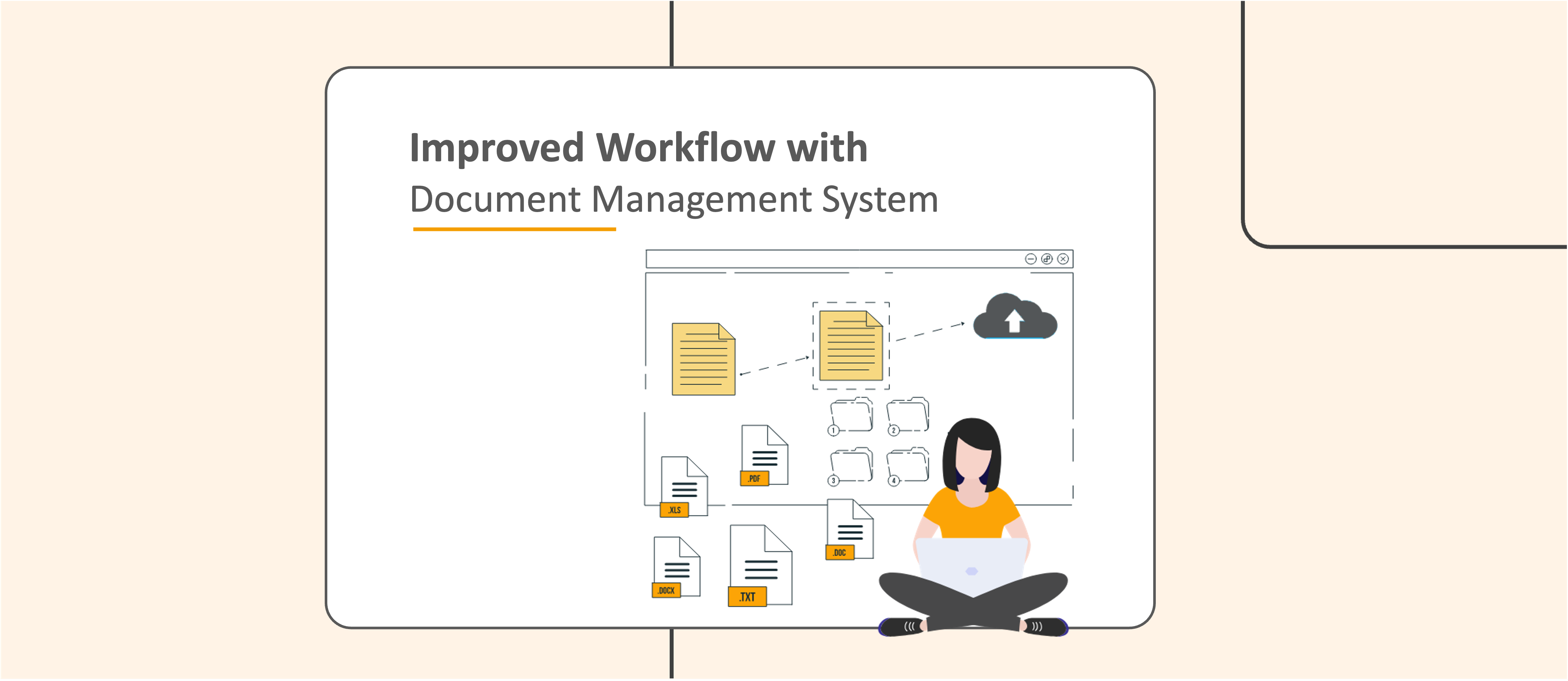Introduction of Document Management System
Document management systems should be implemented by every company, whether large or small. After standardizing document management system implementation, companies understand their dependency on paper, which seems ridiculous. A Document Management System is great software that companies should try for increased and smooth workflow management.
Document Management System – Need Of an Hour and A Perfect tool
A document management system is software that has the capability of recording and modifying data. Companies use such systems to ensure a positive workflow among employees. This improvement occurs due to the increased efficiency of a document management system in handling various files.
Every company needs to store a lot of information about its profits, sales, revenue, employees, etc. These are traditionally stored on paper. Irrespective of how well organized this tremendous amount of paper is, it can be extremely difficult to access the information when needed. Finding the specific data required at the moment can take a lot of time. This waste of time that every department faces whenever they require past data brings the workflow to a screeching halt.
Document Management System – Detailed Overview
Definition
Handling multiple documents and keeping tabs on everyone is a tedious task. Therefore, organizations or companies these days rely on Document Management Systems. DMS helps save, manage, track, store, receive, and access documents anytime easier. Initial concepts of DMS software first started developing in the 1980s. Different users can work on it, and most DMS is capable of history tracking or recording the modifications or different versions created by many people.
Electronic DMS
As an important means of saving paper, every good document management system can store digital documents, and these systems are based on computer programs. There is automated software that works as a document management system that can record business files and documents. This software can also capture, organize, secure, digitize, and approve these files.
File Formats Supported By DMS
Most DMS stores files in their original file format like Excel, Word, Pdf, etc. However, many companies, most of which are web-based, are also choosing to store files in the HTML format. Since most search engines and websites can natively work with HTML, the user experience becomes easier. Data is converted through editors based on the browsers or through converting them beforehand. Additionally, since users are more familiar with internet searching formats, many EDMS software has integrated cluster analysis, queries in boolean, and stemming.
Indexing in DMS
The indexing or profiling of data is the biggest benefit of a document management system. Profiling is the added information that is assigned to each file. This information includes the characteristics of the documents, such as their creator, when it was created, their contents in brief, and the type of file it is. This quick overview makes it easier to organize files both departmentally and companywide.
When this information is entered correctly, finding a document becomes a matter of seconds. Employees do not have to wade through piles of papers to find an invoice or receipt; they have to search it by whatever information they have, like name or date. The overall operation of the company can also be improved through indexing.
There are certain ways in which companies reap the benefits of profiling documents like automated emails, invoice records, previous invoices, their approval, and record retention.
How to Smoothly Implement a Document Management System in a Company?
Every business should have its file management system in place. If you are wondering what document management system control is, it can have access to the complete file system of your company, ensuring increased efficiency of every department. Any company starting the document management system implementation needs to follow a procedure. This procedure should be followed to ensure the implementation of document management system software is successful from the get-go. Here are a few steps that will help companies manage such systems perfectly.
A Team
Companies should create teams that will be in charge of the document management system implementation across the company. It is thus necessary that employees from every department of the company are a part of this team. Any employees’ communication, demands, or requests can be delegated to their respective department members. This makes the process much smoother since adopting a DMS software is a sweeping change that will require some getting used to by everyone.
Current File Management
Before the implementation of document management system, it is important to recognize the current system first. If there isn’t a standard company system already in place, it’s likely that every department has its own way of managing files. To improve these systems, the existing processes need to be recorded in detail. Then, every department can investigate its processes and document management implementation to determine which are the most efficient or popular. This will help standardize the file management system throughout the company.
Access Previous Files
Once a standard has been established, all preexisting files need to be organized through this system. Every department should locate these files, keeping in mind the various places where their files are stored. Departments that have both electronic and physical files should ensure that all documents are entered into the electronic document management software.
Assign personnel to check every cabinet, drawer, and cupboard to ensure no files are missed during the organization. Once every document is recognized, remove unessential documents before files are entered into the system.
Document Management Implementation
For successful document management system implementation, companies should create teams responsible for the process across the organization. It is essential that employees from every department participate in this team. Any communication, demands, or requests from employees can be delegated to their respective department members. This approach makes the process smoother since adopting a DMS software is a significant change that will require adjustment from everyone.
How does document management system implementation improve workflow?
A document management system implementation is widely adopted by companies because it significantly enhances employees’ effectiveness. Here are several ways in which a DMS achieves this:
Superior capturing, indexing and Retrieval of every document
Through a DMS system, every company can process data more systematically. Files are recorded properly with the help of an efficient indexing system. This indexing system also helps with the Retrieval of files whenever required. The index keeps files organized based on their properties. Whenever workers look for a specific file, they can search it on the system and find it at once. This is why document management systems for small firms are beneficial.
Advanced Security, document backup/safety and Great forensic abilities
Sensitive file storing is best done with an electronic file management system. DMS systems have advanced security options that are quite necessary for companies. This softwares have internal file encryption systems that can protect documents. In addition, each file can be programmed to have specific security clearances for specific people. This means employees who have security access to any file are the only ones who can work on them.
Additionally, whenever employees create or modify any file, it is recorded in detail in the softwares. The accountability and history for every file are detailed in the software, so a legal document management system is important. Each document is also backed up into the software, and losing the document is not a possibility.
DMS allows multiple employees to work effortlessly and efficiently on a single document
Nearly all files are worked on collaboratively by multiple people in the company. Therefore, it can be difficult to transfer files to each individual, who will have to transfer the modified file to the next personnel. Various employees can access the same file and work on them without any issues with document management systems. This is a very efficient system that saves time, and the employees’ workflow is better.
Through convenient integration with other softwares, DMS increase efficiency
DMS software also can internally integrate with third-party software. Every document has its format. The files need to be downloaded from the storage to work on and uploaded after work is completed. Employee error is a possibility that might result in the loss of important documents. Due to the sheer amount of workers, document management systems for oil and gas companies are necessary.
Users can take advantage of full-text search
Most document management systems have the process of search engines. Employees can search for files with text input like with internet searches. The finding of files becomes easier with such an easy system of search. The time it takes to look for past files reduces drastically, and this is why document management systems for procurement companies can be beneficial.
Conclusion
The successful implementation of a document management system (DMS) can transform a company’s operational efficiency. The global document management system market is projected to grow from approximately $8 billion in 2023 to about $9.16 billion in 2024, with a compound annual growth rate (CAGR) of 14.5%. By 2028, it is expected to reach around $14.95 billion, driven by the shift from paper to digital documentation, increasing regulatory compliance needs, and the adoption of hybrid and cloud solutions(Research & Markets)
By streamlining workflows and enabling easy access to essential documents, a well-implemented DMS empowers employees to focus on their core tasks rather than getting bogged down in administrative challenges.
For companies looking to elevate their document management processes, exploring specialized solutions such as our Engineering document management system (eDMS) is highly beneficial. Designed to meet the unique needs of engineering firms, this software not only simplifies document storage and retrieval but also enhances collaboration across teams. With features tailored to ensure compliance and security, the eDMS supports businesses in achieving seamless operations and better project management. To learn more about how Zelite’s eDMS can transform your document management practices, visit our Engineering Document Management System.




